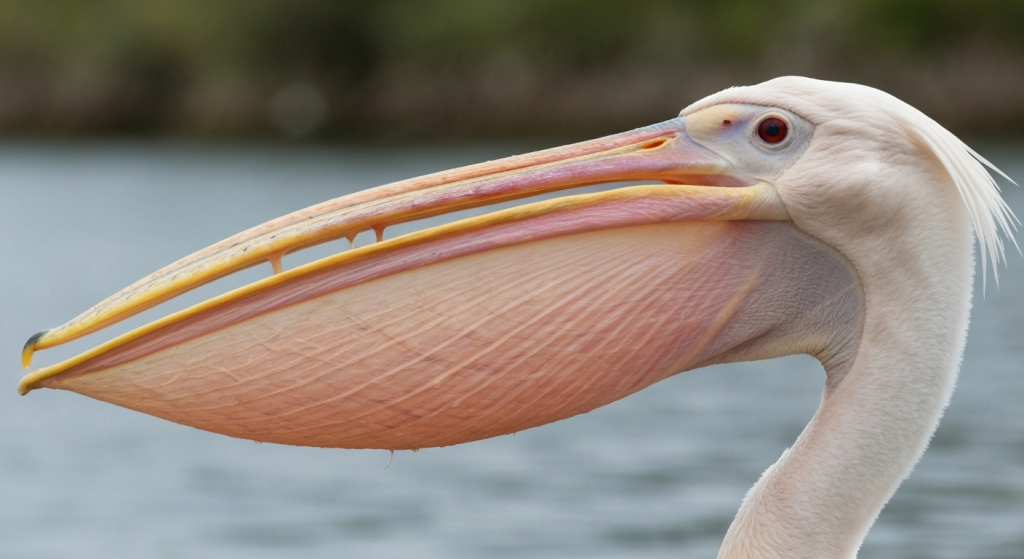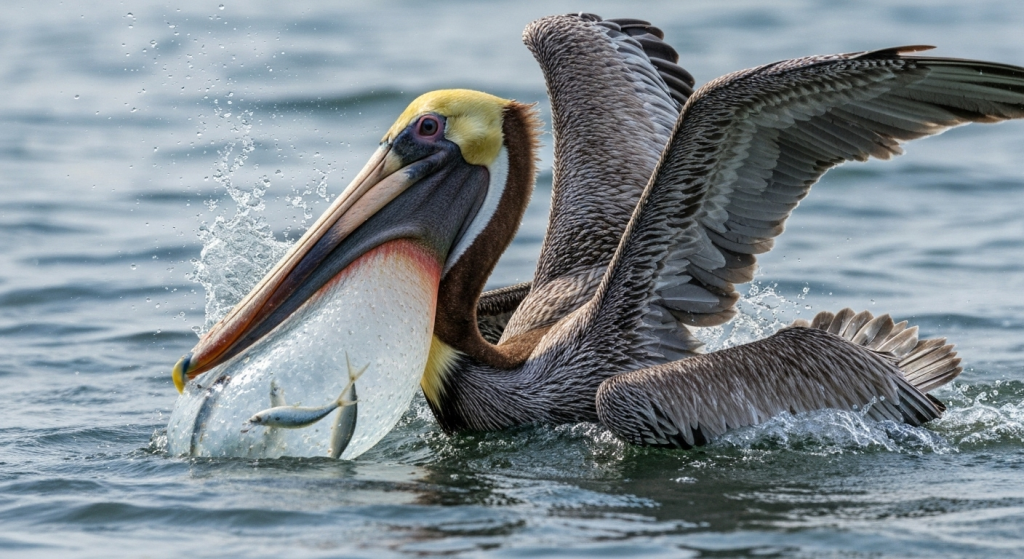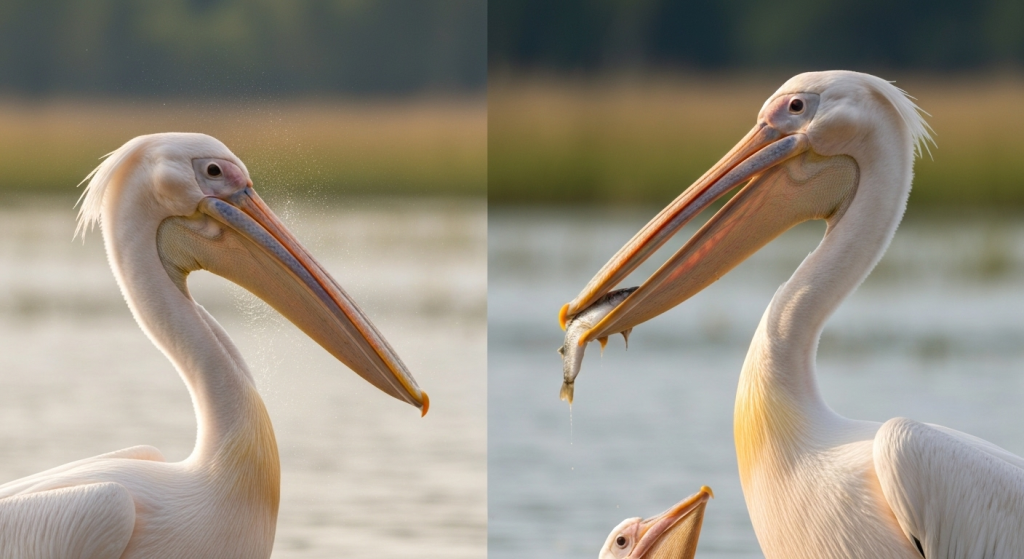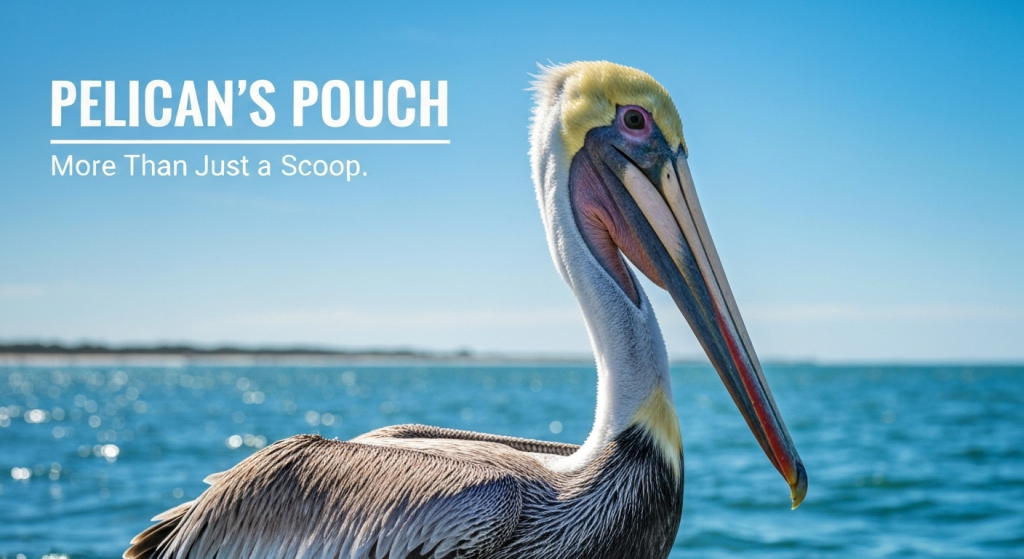If you’ve ever been near a coastline, you’ve likely seen the majestic sight of a pelican. They glide effortlessly above the water before suddenly diving, emerging with a massive, bulging throat. That iconic feature, the gular pouch, is far more than a simple fishing net. It’s a masterpiece of natural engineering—a versatile tool that serves as a high-tech cooling system, a social signal, and even a dinner plate for its young. The pouch is central to the pelican’s identity and survival.
Many people assume the pouch is just for scooping and holding fish, like a built-in grocery bag. But the reality is much more fascinating. The mechanics of how it expands, drains gallons of water in seconds, and helps the bird survive in harsh climates are incredible. Let’s break down the science behind this amazing adaptation and explore what makes the pelican’s pouch one of the most unique tools in the animal kingdom.
My fascination with bird adaptations began years ago, and pelicans have always stood out. As Mahnoor Farooq, I’ve spent countless hours exploring and writing about bird species, trying to connect the dots between scientific research and what we can observe in the wild. This journey isn’t just about academic knowledge; it’s driven by a deep curiosity about how these creatures thrive. After years of fieldwork and writing, my goal remains the same: to share these discoveries in a way that feels clear and exciting, helping others see the wonder I see every day.
Deconstructing the Gular Pouch: A Marvel of Anatomy

At first glance, the gular pouch looks like a simple flap of skin. However, it’s a complex and highly specialized anatomical structure. It’s not just hanging there; it’s intricately connected to the pelican’s jaw and skeleton, allowing for its incredible elasticity and strength. Understanding its design is the first step to appreciating its many functions.
The Pouch’s True Composition
The pouch is primarily made of skin, but it isn’t just loose flesh. It contains a network of fibrous connective tissue and smooth muscle that gives it both its elasticity and its resilience. A key component is a protein called elastin, the same stuff that keeps our own skin flexible. In the pelican’s pouch, however, it’s supercharged. This allows the pouch to stretch to hold up to three gallons of water and fish—roughly three times what its stomach can handle—and then snap back to its original shape without damage.
One of the biggest misconceptions I’ve encountered over my years of observation is that pelicans store food in their pouches. This is incorrect. The pouch is a tool for catching, not for storing. A pelican couldn’t fly with a pouch full of water and fish; it would be far too heavy and cumbersome. The pouch is used to scoop, drain, and position the fish for swallowing.
The Skeletal Framework: How the Jaw Supports the Pouch
The pouch’s functionality relies heavily on the pelican’s unique jaw structure. Unlike most birds, a pelican’s lower jaw (the mandible) is not a single, rigid bone. Instead, it consists of two long, thin, and highly flexible bones. These bones can bow outwards, dramatically widening the mouth’s opening and expanding the pouch’s capacity.
This system is supported by a structure called the hyoid apparatus, a set of bones at the base of the tongue that also anchors the pouch. When the pelican opens its mouth to fish, these bones and the flexible mandible work together to create a wide, gaping net. When it’s time to swallow, the bird contracts its muscles, the jaw bones return to their normal position, and the pouch tightens up.
| Feature | Description | Function |
| Mandible Bones | Two long, flexible bones forming the lower jaw. | Bow outwards to expand the pouch’s opening for catching prey. |
| Gular Skin | Highly elastic skin rich in elastin and connective tissue. | Stretches to hold a large volume of water and fish temporarily. |
| Hyoid Apparatus | A complex of bones at the base of the tongue. | Anchors the pouch and helps control its shape and movement. |
| Muscle Network | Smooth muscles interwoven within the pouch tissue. | Contracts to expel water and retract the pouch after a catch. |
The Ultimate Fishing Tool: How Pelicans Use Their Pouch

The primary and most famous function of the gular pouch is, of course, fishing. But the process is far more precise and efficient than it looks. Different pelican species have perfected different hunting strategies, but they all rely on the pouch as their essential tool. From dramatic plunge dives to coordinated group efforts, the pouch is the star of the show.
The Plunge and Scoop Technique
Brown Pelicans, often seen along North American coasts, are famous for their spectacular plunge dives. From heights of up to 60 feet, they fold their wings and dive headfirst into the water at high speeds. Just before impact, they open their mouths, and the flexible jawbones expand the pouch into a huge, open net.
The impact with the water stuns small fish near the surface, and the pelican scoops them up along with a huge amount of water. Here’s the thing: catching the fish is only half the battle. A pouch full of water is incredibly heavy. A pelican that tried to fly with a full pouch would never get off the ground. That’s where the next step comes in.
Draining the System: Getting Rid of the Water
After a successful scoop, the pelican surfaces and begins the crucial process of draining. It points its bill downward, closes its mouth, and contracts the pouch muscles. This squeezes the pouch against its chest, forcing the water out through the sides of its bill while trapping the fish inside. This process is surprisingly fast, often taking less than a minute. I’ve often watched them from the shore, and it’s a methodical, efficient movement—a perfect example of a purpose-built adaptation at work. Only after all the water is gone can the bird toss its head back and swallow its meal.
Pros and Cons of Pouch-Based Fishing
| Pros | Cons |
| Large Catch Area: The pouch acts as a massive net, increasing the chances of catching fish in a single attempt. | Heavy Water Load: Scooping up gallons of water requires significant effort to drain before flight or swallowing. |
| Effective on Schooling Fish: Ideal for capturing multiple small fish at once. | Risk of Injury: High-speed dives can lead to injury, and the pouch can be damaged by sharp objects or fishing hooks. |
| Stuns Prey: The force of the dive and the sudden expansion of the pouch can disorient fish, making them easier to catch. | Energy Intensive: The entire process, from diving to draining, consumes a lot of energy. |
More Than Just a Mouthful: The Pouch’s Hidden Functions

While fishing is its main job, the gular pouch is a multi-purpose tool that plays a vital role in other aspects of a pelican’s life. These secondary functions are less obvious to a casual observer but are just as critical for the bird’s survival, especially in the warm climates where most pelicans live.
A Built-In Air Conditioner: Thermoregulation
On hot, sunny days, you might see a pelican sitting with its mouth slightly open, rapidly vibrating its throat pouch. This behavior is known as gular fluttering. By fluttering the moist, highly vascularized skin of the pouch, the pelican increases airflow over its surface. This promotes evaporative cooling, much like how a dog pants to cool down.
This is an incredibly efficient way to dissipate body heat without losing excess moisture through respiration. Blood flowing through the dense network of vessels in the pouch cools down as water evaporates from the surface, and this cooler blood then circulates through the rest of the body. In my years observing bird behavior, seeing a whole flock of white pelicans gular fluttering on a sweltering afternoon is a powerful reminder of how elegantly nature solves complex problems like temperature control.
A Social Signal: Communication and Courtship
The gular pouch also serves as a communication tool, particularly during the breeding season. For many species, like the American White Pelican, the pouch and the area around the eyes become a vibrant, bright orange. This change in color signals that the bird is healthy, mature, and ready to mate. Males will perform elaborate courtship displays, bowing, pointing their bills to the sky, and showing off their colorful pouches to attract a female. The pouch essentially becomes a billboard advertising their fitness as a potential partner.
A Temporary Crib: Caring for Young
Pelicans do not carry their chicks in their pouches, a common myth likely started by cartoons. However, the pouch is essential for feeding their young. Adult pelicans swallow fish and partially digest them, creating a nutrient-rich “fish smoothie.” Back at the nest, they regurgitate this mixture. The hungry chicks will then stick their entire heads deep inside the parent’s pouch to eat the regurgitated meal. For the first few weeks of their life, the parent’s pouch serves as their only source of food and water.
Not All Pouches Are Created Equal: Differences Across Pelican Species
The world is home to eight species of pelicans, and while they all share the characteristic pouch, their hunting strategies and pouch adaptations vary. These differences reflect the specific environments they inhabit and the types of prey they hunt. Let’s break down two contrasting examples: the Brown Pelican and the American White Pelican.
Diving Specialists: The Brown Pelican
The Brown Pelican is the only species that exclusively uses the dramatic plunge-diving technique. Its body is built for it. It has subcutaneous air sacs under its skin that cushion the impact with the water, and its pouch is incredibly robust to withstand the force. They are primarily coastal, saltwater birds and often hunt alone, targeting schooling fish like anchovies and sardines. Their pouch is a high-impact, solitary hunting tool.
Cooperative Hunters: The American White Pelican
In contrast, the American White Pelican is an inland species, preferring freshwater lakes and marshes. They are much larger than Brown Pelicans and are not plunge-divers. Instead, they are masters of cooperative hunting. A group of White Pelicans will work together, swimming in a line or a semicircle to herd fish into shallow water. Once the fish are cornered, the pelicans simply dip their heads and scoop them up. Their pouch is used more like a gentle dipping net in a coordinated team effort.
| Feature | Brown Pelican | American White Pelican |
| Habitat | Coastal, saltwater environments. | Inland lakes, rivers, and marshes. |
| Hunting Strategy | Solitary plunge-diving from height. | Cooperative herding in groups. |
| Pouch Adaptation | Extremely tough and resilient to handle high-speed water impact. | Large and voluminous for scooping fish herded into shallows. |
| Breeding Coloration | Pouch turns a duller, olive-green to reddish-brown. | Pouch and facial skin become bright, vibrant orange. |
Frequently Asked Questions (FAQs)
How much water can a pelican’s pouch hold?
A pelican’s pouch is incredibly expandable and can hold up to 3 gallons of water. This is about two to three times the capacity of its stomach. They must drain all this water before they can swallow the fish they’ve caught.
Do pelicans store food in their pouch for later?
No, this is a common myth. The pouch is used only for catching prey and as a temporary container while the water is drained. Once the water is gone, the pelican swallows the fish immediately.
Can a pelican breathe with a full pouch?
Yes, a pelican’s windpipe (glottis) is located at the base of its tongue and can still function even when the pouch is full of water and fish. They can breathe normally during the draining process.
How do pelican chicks eat from the pouch?
Parents regurgitate partially digested fish into their pouches, creating a food source for their young. The chicks stick their heads directly into the parent’s large pouch to feed on this mixture.
Conclusion
The pelican’s gular pouch is a testament to the power of evolutionary adaptation. It’s so much more than a simple scoop. It’s a precisely engineered fishing net, an efficient personal cooling system, a vibrant social signal, and a nurturing tool for raising the next generation. From the high-speed dives of the Brown Pelican to the coordinated hunts of the American White Pelican, this single feature enables a wide range of behaviors and allows these remarkable birds to thrive in diverse environments across the globe. The next time you see a pelican, look beyond the impressive scoop and appreciate the complex, multi-functional tool that makes it one of nature’s most successful survivors.


